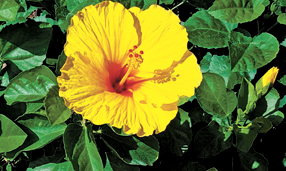Hibiscus is in the Malvaceae family of tropical plants and are known worldwide as the poster plant for tropical islands. You can hardly see an advertisement about an island getaway that doesn’t feature one of these lovely flowers.
A dwarf hibiscus is a variety of hibiscus plant that has been cultivated to be used as an indoor flowering plant and also does well planted outdoors as a lower ground cover variety of hibiscus. It grows between 2 to 3 feet instead of 6 to 8 feet (or more) as with traditional hibiscus. Dwarf hibiscus are not genetically distinct but are dwarfed using a growth regulator. This dwarfing is not a permanent change though, and the plants will eventually reach normal hibiscus heights within a few years.
Several varieties of dwarfed hibiscus are available, with clusters of buds in shades of red, pink, deep red, orange, apricot, orange-bronze and white. Spraying the hibiscus with growth regulator results in stunted growth immediately, which manifests the growth of smaller new leaves and stems. However, the size of the flowers remains the same as those of the untreated hibiscus. The dwarfing process also promotes the growth of deeper green leaves and the production of five buds instead of just one, making this one of the most dramatic hibiscus for the money.
In our area these dwarf hibiscus are only available from growers on a seasonal basis usually during the cooler months. Suitable uses would be as an annual (you will get a more extended life from them), an indoor plant on a lanai or porch and as a tropical table arrangement for parties. They do like regular watering, but do not overwater them. If you are planting them in the ground, they prefer full sun, a little fertilizer in late spring and a light trimming to keep the shape will be all that is necessary to keep these dwarf hibiscus going into summer.
This column is a joint effort by all at In The Garden, Sanibel’s local garden center located at 3889 Sanibel Captiva Road, Sanibel Island, Florida.
